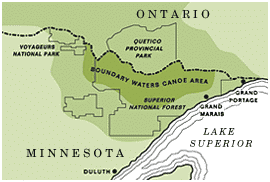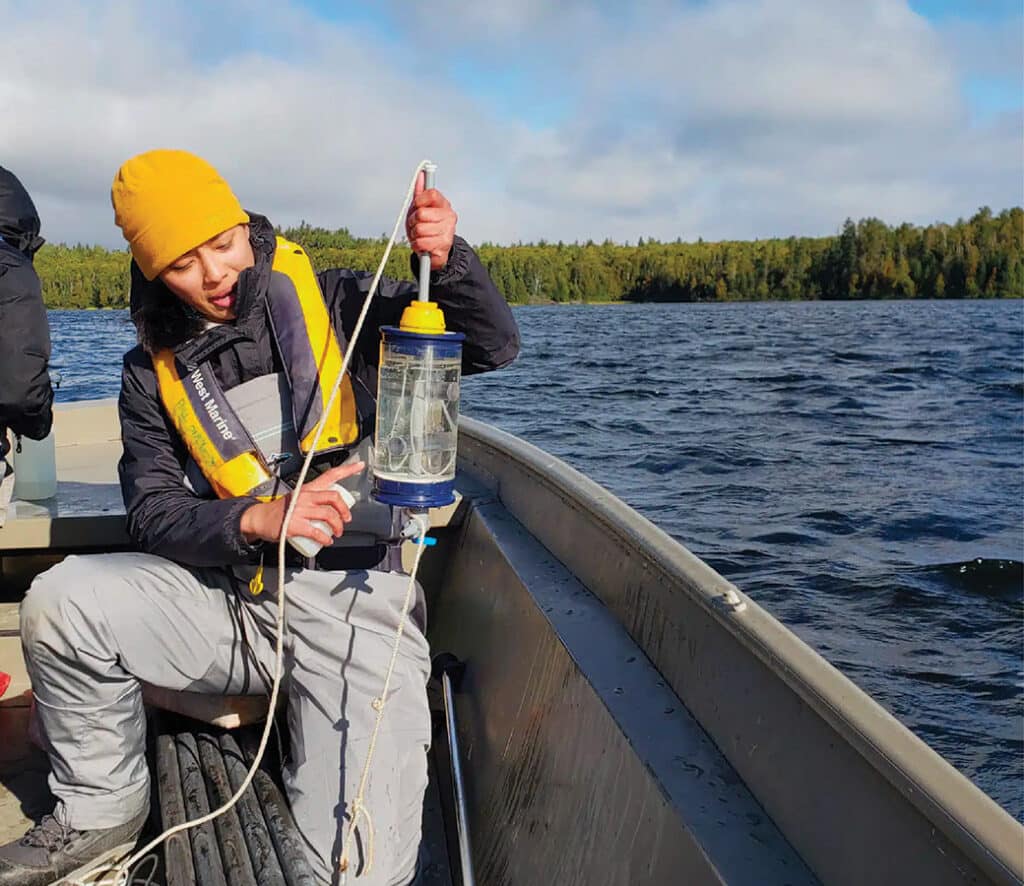
When paddlers travel through parts of the Boundary Waters Canoe Area Wilderness (BWCAW), they may notice a thin green slime coating the lake’s edges. Cyanobacteria, or blue-green algae, now appears more frequently in waters throughout the Superior National Forest (SNF) and the wilderness. Researchers are working to understand why this toxic algae is increasing in these protected areas. The Minnesota Legislature awarded $1.3 million to the environmental research division of the Science Museum of Minnesota. Researchers will use the funding to study the causes of the algae’s growth and understand how it may impact the future health of the lakes. While visitors should assess their own risk, there are ways to help limit exposure.
Three-year study will look at causes
Blue-green algae (cyanobacteria) typically emerge in mid to late summer on lakes near urban or agricultural areas. They form a scummy greenish layer that usually appears along shorelines and sometimes spreads across entire lakes. Researchers at the Science Museum of Minnesota report that blooms continue to appear in unexpected parts of the SNF and BWCAW. This development raises concern in a region known for its exceptionally clean and clear lakes.
Scientists began monitoring cyanobacterial blooms three years ago when they noticed the algae appearing more frequently throughout the national forest. Now, with a $1.3 million grant from the legislature, they will continue investigating the primary sources of these toxic blooms.
During their initial study, researchers believed that dust drifting from the Dakotas increased phosphorus levels in regional waters and triggered the blooms. Lienne Sethna, Assistant Scientist at the St. Croix Watershed Research Station and one of the project leaders, said, “Slowly, we’re seeing an increasing trend of algae growth over time, especially since the 1950s, which coincides with the industrial boom.”
However, after completing that study, the team concluded that dust does not appear to cause the majority of the problem. While regional nutrient inputs likely contribute somewhat, they believe lake sediments release a significant portion of the phosphorus, likely due to a trend of warming waters.
“Unfortunately, we can’t point to a factory or municipality dumping phosphorus into these lakes,” Sethna added. “Many of these lakes sit far from agricultural activity, which we’d normally expect to play a role. These lakes are warming, and we care deeply about that.”
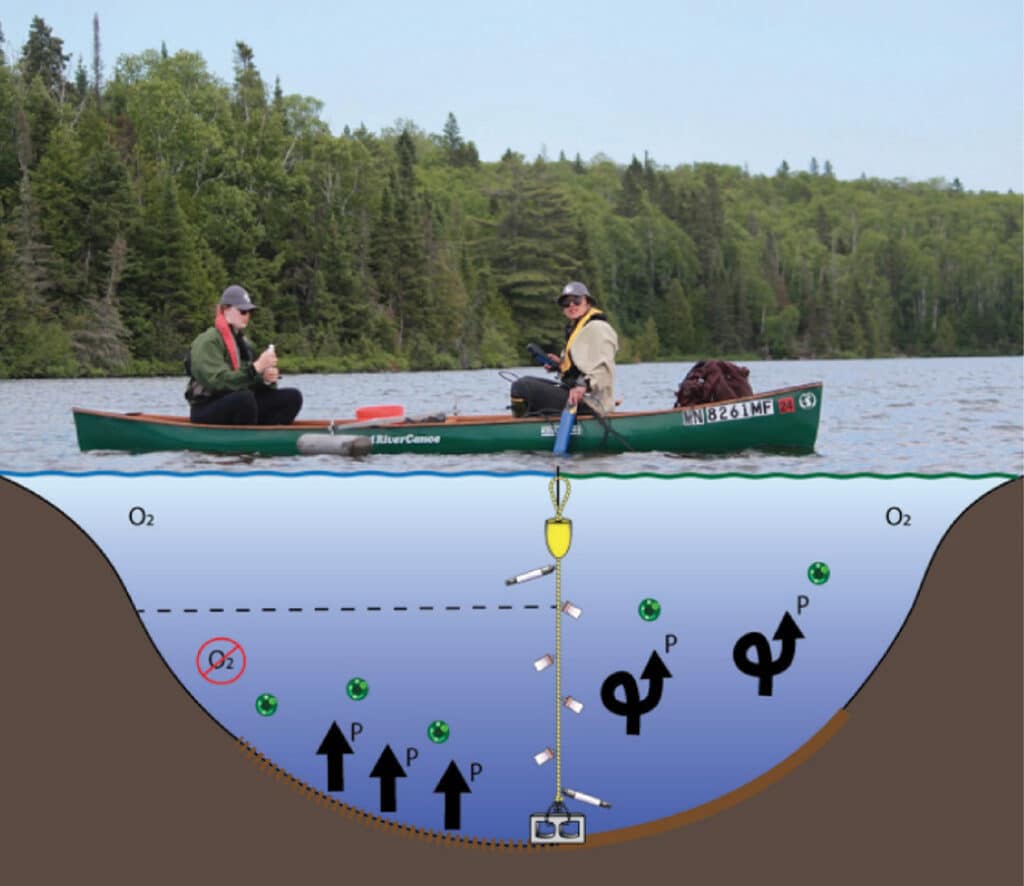
Tracking phosphorus in lakes
Lakes in northern Minnesota tend to be cool and stratified. This means they have warmer water layers near the surface and cooler layers near the lakebed. The bottom layer often lacks oxygen, creating conditions that allow phosphorus to release from sediments and rise toward the warmer surface water.
When wind and storms mix the water, they distribute phosphorus from the bottom layers throughout the water column. “But when you have mixing, that phosphorus in the bottom waters gets distributed through the water columns, and you get blooms,” said Sethna. This mixing process is known as anoximixis. As the water stays warmer longer, buoyant cyanobacteria float to the surface, absorb more sunlight, which encourages their growth.
In this second phase, the research team now aims to determine whether a kind of “phosphorus recycling” within the lakes drives the increase in cyanobacteria blooms and the toxins they release. This process could be the culprit in increased blooms. The team will deploy buoys this fall to monitor temperature and oxygen levels. Sethna said the researchers will begin full-scale monitoring and sampling in May 2026.
They will collect data from the lakes throughout the summer, including incubation cores that capture a snapshot of activity just beneath the sediment. In the winter, they will extract larger, deeper sediment cores to analyze environmental changes spanning the last 150 years. This information will reveal how much phosphorus the sediments store, how much phosphorus they release, and the potential for future mixing and release. Additionally, they hope to discover whether this represents a new normal or if algae blooms will fluctuate and move downstream, reducing phosphorus levels.
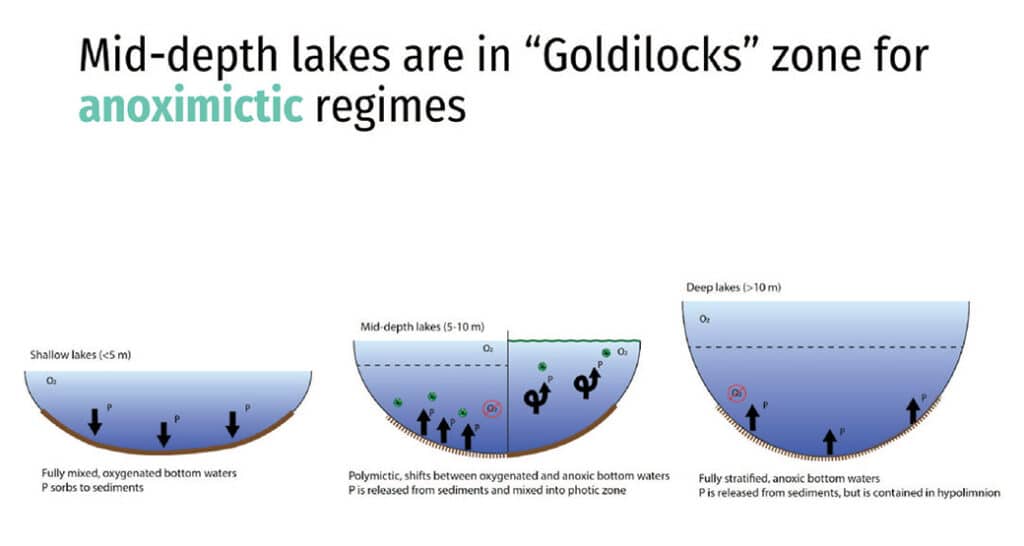
Research includes Tribal groups
It’s a big project involving multiple partners. This summer, the research station is coordinating with project partners, including the 1854 Treaty Authority and the Red Lake Department of Natural Resources. The St. Croix Research Station will expand its work to six lakes within the Superior National Forest (SNF) and Boundary Waters Canoe Area Wilderness (BWCAW). These include three bodies of water near Sawbill Lake that researchers studied in 2022 and will continue to monitor during the project’s second phase.
Meanwhile, other partners will monitor ten additional lakes across the national forest. Tribal groups will not only collect data and monitor water quality but also study how rising phosphorus levels affect wild rice production.

Building blocks of life
Cyanobacteria have existed for billions of years. They were among the first organisms to photosynthesize and produced the oxygen that shaped Earth’s atmosphere, forming the foundation of life on our planet. These bacteria thrive in warm conditions. Sunlight warms stagnant water that is rich in nutrients like nitrogen and phosphorus. This creates an ideal environment for cyanobacteria to flourish.
Although cyanobacteria don’t directly cause disease, they can release toxins under certain conditions. These toxins trigger harmful blooms that affect people, wildlife, and ecosystems. The blooms may spread across the water’s surface, creating a thick layer that looks like pea soup. People should not confuse this with the yellow pollen that coats lakes in spring and early summer. They should also not confuse it with duckweed, a harmless, tiny, free-floating aquatic plant.
Beyond looking and smelling unpleasant, cyanobacteria blooms can cause rashes, stomach issues, and even damage the liver and nervous system. By depleting oxygen in the water, they also harm aquatic life.
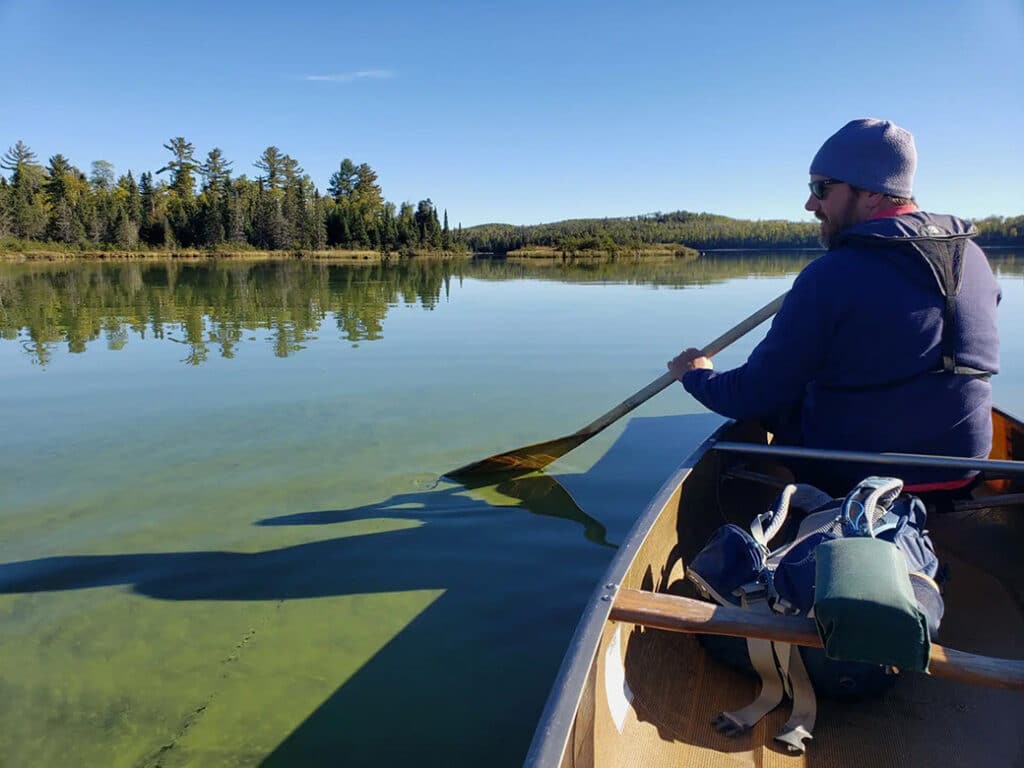
What does it mean for wilderness visitors?
Eventually, the U.S. Forest Service–Superior National Forest will partner with the research station to post signs at certain entry points. These signs will alert visitors about blue-green algae blooms in specific lakes. “One of our goals is to help identify which lakes are at risk,” Sethna said. She noted that shallow to moderately deep lakes warm faster throughout the season, increasing their likelihood of developing blooms.
Visitors to the BWCAW and surrounding forests rely on these lakes for drinking water. Most use multiple methods to treat and filter the water. However, not all methods remove toxic algae. A two-step method may be best on high-risk lakes. Experts recommend starting with a gravity filter that uses a hollow fiber membrane. This type of filter usually includes a dirty water bag and a clean water bag. A hose and filter between the two bags removes bacteria, protozoa, and particulates. According to the Environmental Protection Agency (EPA), filters with smaller pore sizes physically block and remove cyanobacteria cells.
If cyanobacterial cells have broken apart and released toxins into the water, a gravity filter may not effectively remove the toxins. As a second step, users can include a separate filter containing powdered or granular activated carbon, which may help remove some toxins. However, its effectiveness depends on the type of carbon, the specific toxins present, and the overall water quality.
This setup is often part of a pump filter system. A tube suspended in the water draws up the dirty water, which passes through the filter, which contains activated carbon. This flows through a clean tube into a container or water bottle. During an algae bloom, users should also clean or replace their filters more frequently to maintain performance.
Finally, the EPA does not specifically direct these recommendations toward the SNF or BWCAW but instead provides general guidance for treating cyanobacteria.
Avoid collecting drinking water near visible algae blooms
To reduce risk, people should avoid collecting drinking water near visible blooms. Instead, they should gather water from the middle of the lake or from moving creeks and streams. They should also watch for posted signs warning visitors about blooms in lakes. Finally, boiling water can kill cyanobacteria cells. However, this process also releases toxins into the water, making it more dangerous to drink. If in doubt, it may be a good idea to have two different methods for filtering and treating water.
No immediate solution
Although scientists are searching for a long-term solution, no effective fix exists yet for blue-green algae in wilderness waters. More locally, the Minnesota Pollution Control Agency oversees alum treatments in urban waters to reduce toxic blooms. This chemical treatment binds to the phosphorus, essentially locking it into the sediment. However, scientists at the research station say this treatment is not the best option for wilderness and remote lakes. Sethna noted that alum is expensive, invasive, and unsuitable for “pristine lakes.”
The team will continue collecting data while monitoring lakes continually for the next three years. The Science Museum of Minnesota is collaborating with multiple partners for this project, including the St. Croix Watershed Research Station, the Red Lake Department of Natural Resources, the 1854 Treaty Authority, the USFS-Superior National Forest, and the Minnesota Pollution Control Agency.
The St. Croix Watershed Research Station encourages visitors to the Boundary Waters and Superior National Forest to submit photos with dates and locations of cyanobacteria blooms they encounter. Submissions may be sent to Lienne Sethna at lsethna@smm.org or researchstation@smm.org.

More info:
- Scientists examine lake mud to learn why toxic algae is in protected lakes – KAXE
- Learn about Harmful Algae, Cyanobacteria, and Cyanotoxins – U.S. Environmental Protection Agency
- Cyanobacteria Blankets of Doom: Causes and Effects of Toxic Blooms – American Society for Microbiology

